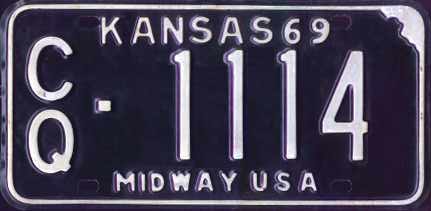

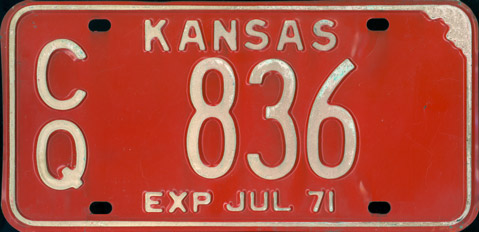

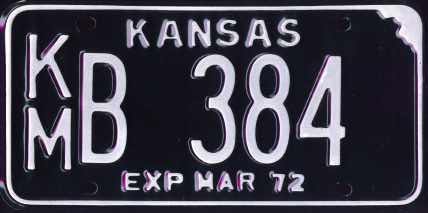
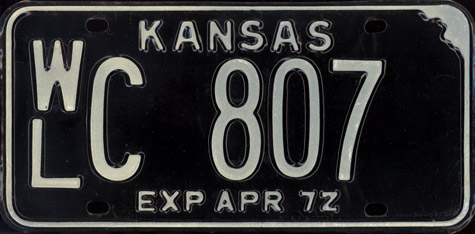

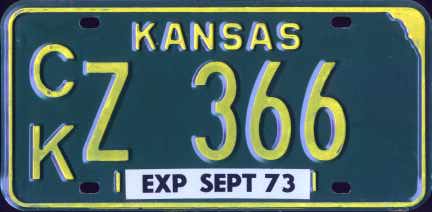
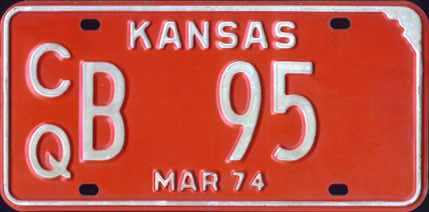
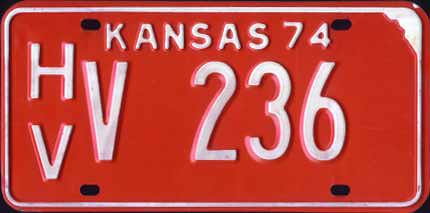
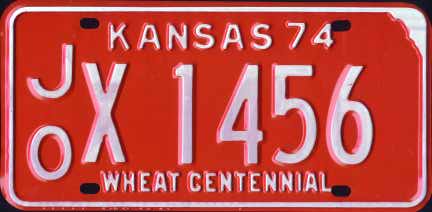

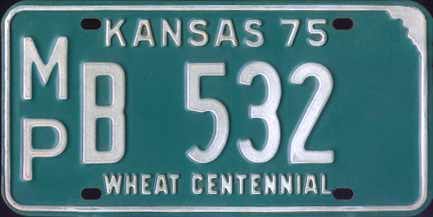
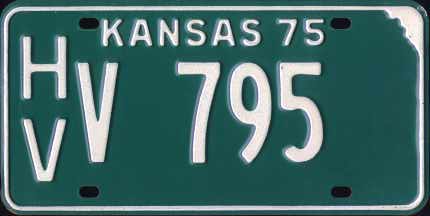
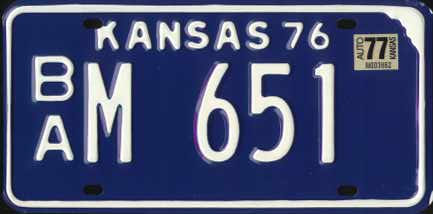
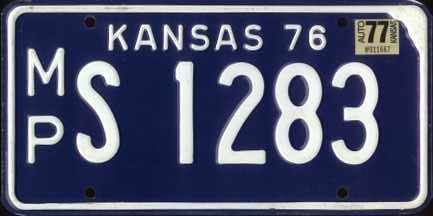
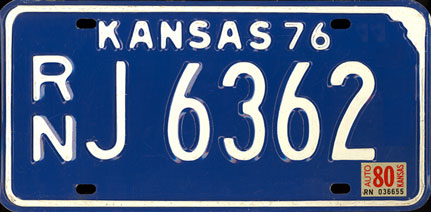
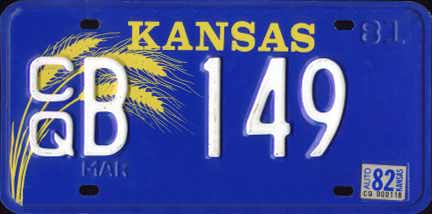
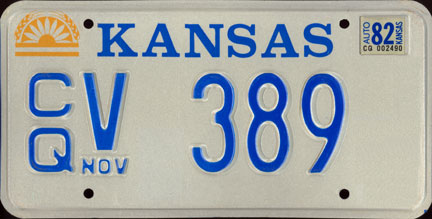

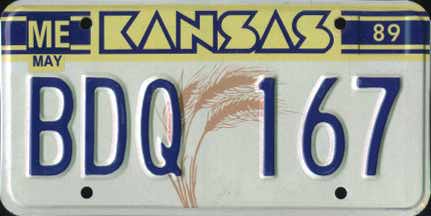
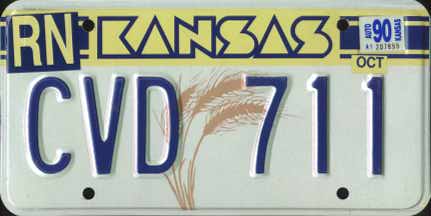
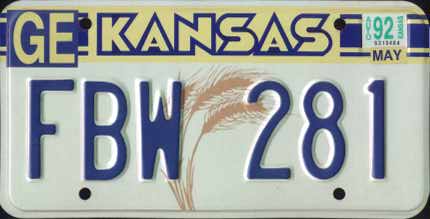

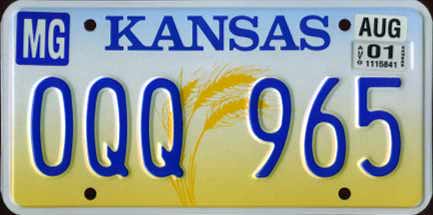
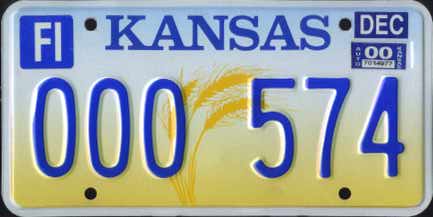
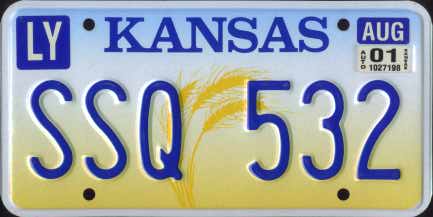


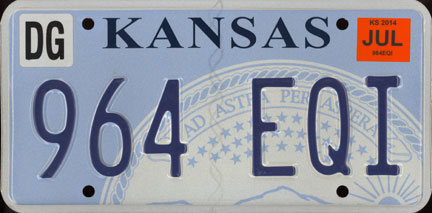
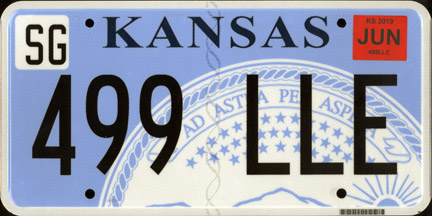

 |
Kansas 1969 passenger issue. Kansas introduced a state-shaped border and stacked two-alpha county code in 1951, with the 1951-55 plates actually having the top right corner cut to the state shape. A state-shaped border was introduced in 1956 (when federal plate size and shape standards came into play) and was used from 1956 through 1980. This plate features the state-shaped border, county code "CQ" for Chatauqua county, and the "Midway U.S.A." slogan, used from 1965 through 1970. Click here for a complete listing of Kansas county codes. |
 |
Kansas 1970 passenger issue. Same format as above in white-on-green colors. This plate again carries the "CQ" county code, for Chatauqua county. This was the last year for the "Midway U.S.A." slogan. |
 |
Kansas 1971 passenger issue. In 1971, staggered registration was started in Kansas, and an embossed month of expiration was added to the plate in place of the slogan. Early plates in the series used the same format as previous issued, with a county code and numeric serial. This plate again came from Chatauqua county. |
 |
Kansas 1971 passenger issue. During 1971, the state added a separate alpha character to the serial to denote the month of expiration. This system seems to have been implemented with August 1971 expirations (embossed with a leading "M" alpha to denote August expiration) and remained on Kansas plates through 1988. This plate is a Chatauqua county issue expiring in September, which was assigned alpha character "R." |
 |
Kansas 1972 passenger issue. This plate again features an embossed date and alpha date and county codes. County "KM" indicates Kingman county, and "B" plates expired in March. |
 |
Kansas 1972 passenger issue. Some 1972 Kansas plates used a very angular '2' die in the expiration date, leading to plates such as this which appear to expire in April, 197Z. This was such a plate from Wilson county (WL). |
 |
Kansas 1973 passenger issue. This plate was issued in Wyandotte county ("WY") and expired in September, as did all "R" plates. |
 |
Kansas 1973 passenger issue. This is an example of an overflow issue, using the letter "Z" in the position where the date code would usually go. The month of expiration of a Kansas plate is determined by the registrant's last name and is embossed in the plate, so in the case that a county ran out of plates stamped for a particular month, a plate like this would be issued with a sticker indicating the correct expiration month. The 1973 issue of these plates had bars at the bottom to indicate sticker placement, similar to non-passenger plates of the era. This plate was issued in Cherokee county (CK). |
 |
Kansas 1974 passenger issue. Kansas issued three different varieties of 1974 plate, all white on red. This issue follows the standard format from 1973, with embossed date at the bottom. It was issued in Chatauqua county ("CQ") and expired in March ("B"). |
 |
Kansas 1974 passenger issue. The second variety of 1974 Kansas passenger plate used this format, with "74" moved to the top of the plate and the embossed expiration month removed, leaving the bottom of the plate blank. These plates were the first to rely entirely on the alpha code to signify the month of expiration. This plate was issued in Harvey county ("HV") and expired in November ("V"). |
 |
Kansas 1974 passenger issue. Later period 1974 Kansas plates appear to have been made in the 1975 format, using the embossed year at the top and a new slogan, commemorating the "Wheat Centennial". I myself thought that wheat had been around a long time previous to 1874-75, but who am I to question Kansans? The reason for this "preview" of the 1975 format is that Kansas assigns registration months based on the registrant's last name, so new registrants with late-year expirations required additional 1974 plates to be made while production of the 1975 plates was in full swing. Rather than switch the dies entirely, plates were made in the 1975 format with a 1974 date and colors. This plate was issued in Johnson county again ("JO") and expired in December according to the "X" date code. |
 |
Kansas 1975 passenger issue. Most 1975 Kansas plates were issued in the same style as the later-period '74-base "Wheat Centennial" plates, with the colors changed to white on green. Again, I'm not sure what this Centennial actually was celebrating, but that's OK. This plate came from Linn county ("LN") and expired in October ("S"). This was the last of the yearly issues for Kansas. |
 |
Kansas 1975 passenger issue. Another 1975 "Wheat Centennial" plate, this one struck me as looking odd when I bought it, and sure enough, the dies are different from the plate above. The shape of the "5" is probably the most evident feature to look at. These plates appear to be made by the Polyvend Corp. in Arkansas, who were also contracted to produce some of the Kansas 1976-base plates. This plate was issued in McPherson county, indicated by the MP code. |
 |
Kansas 1975 passenger issue. Some later-issue 1975 Kansas plates were issued with the "Wheat Centennial" slogan removed from the bottom of the plate. Plates such as this Harvey county, November ("V") expiration issue did not feature the slogan. Again, this is due to additional 1975 plates being required for late-year expirations after production of the 1976 plates had already begun. This plate has the same dies as the one above, suggesting that it was made by Polyvend as well. |
 |
Kansas 1977 passenger issue (1976 base). This plate was first issued at the end of 1975 and was used with stickers through the end of 1980. It again features the state-shaped border, county and date codes, but no slogan or embossed expiration month (the codes were probably well-enough known by then to stand alone). This plate was issued in Barber county ("BA") and expired in August according to the "M" date code. |
 |
Kansas 1977 passenger issue (1976 base). Some 1976-base Kansas plates were produced out of state by the Polyvend Corporation of Arkansas. These plates use dies similar to those used on Illinois plates of the era. This is such a plate, issued in McPherson county ("MP") and expiring in October ("S"). |
 |
Kansas 1980 passenger issue (1976 base). A production variation appeared near the end of this baseplate's issuance in 1980 when new plates were produced using the lighter blue background to be introduced on the state's upcoming 1981 graphic plate. These plates are also marked by plain unpainted aluminum backs but are otherwise identical in design to the previous 1976 Kansas-die issues. This was such an issue from Reno county ("RN".) |
 |
Kansas 1982 passenger issue (1981 base). This new baseplate was issued to all motorists at the expiration of their 1980 plates. It is the first Kansas plate since 1951 not to feature the state shape around the outer border of the plate. This issue, featuring a stalk of wheat in the corner, was very well received and in fact was the ALPCA Plate of the Year in 1980. Visibility and durability issues caused this plate to only be issued for two years, but it could be renewed through 1988 with stickers. This plate came from Chatauqua county, code "CQ" and expired in March ("B"). In addition to the date code, this plate had the month lightly embossed but not painted under the date code alpha. "81" is also debossed in the top right corner of the base. |
 |
Kansas 1982 passenger issue. In 1982, Kansas began issuing these new plates to all new registrants, with new registrants with birthdays in November and December actually getting exp. 1982 stickers on the plate. They were used concurrently with the 1981 base through 1988. It features a sunflower and wheat logo at the top left corner. This plate also added an embossed and painted expiration month below the date code letter. This plate was also issued in Chatauqua county, code "CQ", and expired in November. This baseplate was used with stickers through 1988. |
 |
Kansas 1988 passenger issue. Starting in 1988, all motorists were issued this new graphic base, featuring a stalk of wheat in the center and bizarrely scripted state name at the top. This base introduced a more standard ABC-123 format and county and date codes were eliminated in favor of plate stickers. Legibility issues came up with both the state name and the county sticker on this base, with larger county stickers issued and the state name redesigned on later plates of this base. Again, the way expirations are established in Kansas resulted in some backdated bases, with this plate having an 88 sticker over a screened 89 on the plate. |
 |
Kansas 1989 passenger issue. Standard (non-backdated) version of this plate, with the screened 89 expiration used on the majority of these plates upon issuance. This plate was issued in Meade county, indicated by the "ME" sticker at top left. |
 |
Kansas 1990 passenger issue. Continuation of the original 1989 base, this plate was re-validated for 1990. At the time, the motorist received a larger month sticker for the top corner of the plate and a replacement month sticker to place at the right of the plate, beneath the year sticker. If you look closely at the plate, you can see the imprints of the old, smaller county sticker and original month sticker under the new, improved county sticker. This plate was issued in Reno county, indicated by the now-huge "RN" sticker. |
 |
Kansas 1992 passenger issue. This is the redesigned base with a more legible state name. This change was made to plates near the end of the "D" series. Plate is the same as the above issue otherwise. This plate was issued in Geary county, code "GE". Again, these plates were valid with stickers through 1994. |
 |
Kansas 1996 passenger issue. These plates were first issued at the 1994 expiration of the previous base, and remain the current Kansas issue. The numbering series picked up where the previous plates had left off, near the end of the "G" series. This plate was issued in Labette county, "LB". It features a "Q" and triple repeating digits within the serial, making it one of my favorites. This plate was also an ALPCA favorite, winning Plate of the Year in 1994. |
 |
Kansas 2001 passenger issue. Continuation of the above baseplate. Kansas is one of the few states to make full use of the letters I, O and Q in any position on the plate, resulting in these "Oxx" series plates having been issued. There are reportedly plates in the "OOO" series, which must look pretty odd. Starting with some 2000 expirations, a new county sticker type was introduced, similar to the ones used on the 2001 base, but of a different color. |
 |
Kansas 2000 passenger issue. See, told you the OOO series looked pretty odd. |
 |
Kansas 2001 passenger issue. This is one of an odd series of plates in that the new base of Kansas plates was produced starting at the PBA series, meaning that this baseplate was supposed to wind up no later than the PAZ series. In 2000, however, it became apparent that more plates would be needed by the end of the year. Rather than rolling out the new plates early, additional plates were produced in the Sxx series on this base. Strangely, the new base passed through the middle of the Sxx series before the changeover was complete, so presumably the block of Sxx plates used on this base had to be skipped over on the 2002 base. |
 |
Kansas 2002 passenger issue. These plates were introduced in January, 2001 and replaced the previous base by the end of December, 2001. This graphic features the state capitol building in Topeka, set against a blue sky with clouds. The wheat motif from recent baseplates continued as well, in the form of stalks of wheat peering up from the gold fade at the bottom of the plate. This plate was issued in Leavenworth county (LV). |
 |
Kansas 2008 passenger issue. Kansas began issuing a new graphic in April 2007, featuring a portion of the state seal in the background. The serial format on this base was reversed to 123-ABC, the previous ABC-123 arrangement having reached the high X series on the previous base. |
 |
Kansas 2014 passenger issue. Continuation of the Ad Astra base. Kansas began issuing these single month and year smart stickers for some 2013 and all 2014 expirations. As a result, plates started appearing in 2013 with the sticker well that had previously been used for the separate year sticker removed. The plates remained otherwise unchanged. |
 |
Kansas 2019 passenger issue. In August, 2018, Kansas switched from an embossed to a flat plate. This change appeared in the late LJW series. The new plates use 3M's "Minnesota" serial font, switched from blue to black, and also feature a pre-printed county code designation at top left instead of the previous decal arrangement. The state also changed to 3M's "HD" sheeting at the same time. |
Additional Kansas information provided by: Richie Kennedy, Chuck Sakryd
| Ahead to Kentucky | |
| Back to Iowa |
Return to U.S. Plates Index
Last Modified 8/4/2022 (changed 1970 and 1971 plates, added second 1972 plate).